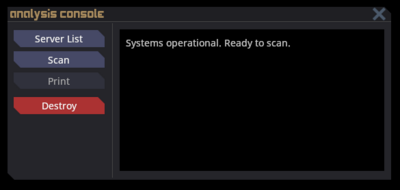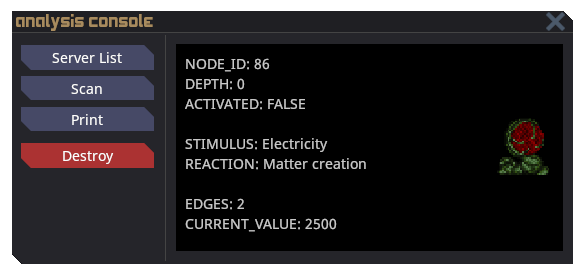(Add the reactions possibility for artefacts) |
mNo edit summary |
||
| Line 104: | Line 104: | ||
* '''Extreme pressure''' | * '''Extreme pressure''' | ||
*:*Low Pressure, put the artefact in a room with less than 50 kPa pressure. Carry the artefact into space or space the room it is in. | *:*Low Pressure, put the artefact in a room with less than 50 kPa pressure. Carry the artefact into space or space the room it is in. | ||
*:*High Pressure, put the artefact in a room with more than 385 | *:*High Pressure, put the artefact in a room with more than 385 kPa pressure. | ||
<!-- --> | <!-- --> | ||
* '''Standard atmospheric gases''' | * '''Standard atmospheric gases''' | ||
Revision as of 11:18, 23 September 2023
Xenoarcheology is a method of point generation for R&D utilizing randomly generated artifacts. It is the job of acolytes to discover and activate the secrets of these artifacts.
Equipment
The actual experimentation of artifacts uses a variety of equipment that can be found scattered around the station. This specifically focuses on the specific items used and contained within the xenoarcheology lab.

Analysis Console
The analysis console is the main method of getting information about the artifacts that are being researched. In order to properly use it, it must be linked to an artifact analyzer via multitool as well as have a research server selected.
From the console itself, the screen displays information about the last artifact scanned. The buttons along the side perform various functions:
| Button Name | Description |
|---|---|
| Server List | Opens a menu for selecting a research server. |
| Scan | Scans the artifact currently on top of the linked pad. Scanning has a large energy intake and takes about a minute to complete for base-level artifact analyzers. |
| Prints a paper copy of the scan. Can only print one copy per scan. Useful for manually organizing scans. | |
| Extract | Extracts the research points from the artifact. The amount of points is based on how many nodes have been activated and will increase the glimmer count. |
Artifact Analyzer
The artifact analyzer is a machine used in conjunction with the analysis console to scan artifacts to discover information about them. It can be upgraded with machine parts in order to reduce its power intake as well as the duration of its scans. Artifacts are scanned by placing them on this machine and then pressing the "scan" button on the console, which will cause it to scan. The scan will be interrupted by either the artifact being moved off of the artifact analyser or by the artifact being activated.
Artifacts
Artifacts are the core of Xenoarcheology and are what acolytes will be analyzing and experimenting on. Artifacts can take on a variety of random appearances and can be acquired in various ways, such as through finding them in the lab at the start of the round, purchasing them from Cargo, getting them from Salvage, or finding them from the Bluespace Anomaly station event.
Artifacts consist of randomly generated "trees" which dictates the artifacts behavior. Each tree consists of various "nodes" which the artifact can be inside of. Nodes each contain a "trigger" and an "effect". Effects can be both passive, constantly occurring while inside the node, or active, occurring only when the artifacts trigger is met. Triggers cause the artifact to shift to a random adjacent node in the tree.
The activation of the various nodes is the main goal of Xenoarcheology. Unlocking the nodes of an artifact increases its value, both in research points and in spacebucks.
Analysis Interpretation
Each scan of the artifact analyzer gives various data about the artifact:
| In-Game Phrase | Meaning | Description |
|---|---|---|
| NODE_ID | ID | A unique ID number corresponding to each node. Can be used for identification. |
| DEPTH | Node tree depth | The distance from the starting node of the tree. Higher depths correspond to more dangerous and harder to activate artifacts which in turn increase the value when discovered. |
| ACTIVATED | Activation | Whether or not the "trigger" for the node has been activated. |
| STIMULUS | Trigger | A hint about the specific trigger for this node. Usually gives a good idea about what activates the artifact. |
| REACTION | Effect | A hint about the effect for this node. Usually is vague and non-specific. |
| EDGES | Neighboring nodes | The number of nodes that are adjacent to the current node. This is the number of different options for traversal when the artifact is activated. |
| CURRENT_VALUE | Point value | The number of research points that the artifact will give if extracted. |
It is important to note that each scan functions as a static snapshot of the current node. It does not update with the artifact and will only update when scanned again.
Stimulus
Some of the given hints for triggering an artefact are used for different scenarios, see Physical trauma which can vary from hugging it to attacking it.
- Electricity
- High temperatures
- Physical trauma
- Brute damage, punch the artefact or hit it with a blunt object via Combat Mode. This may take several hits.
- Interaction, touch or pull the artefact with your hands.
- High damage, the artefact must receive 500 points of damage.
- Tool usage
- Sonic vibrations
- Play a musical instrument close to the artefact.
- Hydro-reactive
- Reacts to water, spray a water on it using a File:Spacecleaner.png spray bottle or File:Fire extinguisher.png fire extinguisher.
- Magnetic waves
- Life essence
- Kill something near the artefact.
- Radiation
- The artefact must take at least 50 points of radiation damage.
- Extreme pressure
- Low Pressure, put the artefact in a room with less than 50 kPa pressure. Carry the artefact into space or space the room it is in.
- High Pressure, put the artefact in a room with more than 385 kPa pressure.
- Standard atmospheric gases
- Place the artefact in a room with either Oxygen, Nitrogen or Carbon Dioxide gas.
- Gaseous plasma
- Place the artefact in a room with Plasma gas.
- Active deceleration
- Throw the artefact, it must land on something.
- No Stimulus
- Time based, it will have a chance to activate every 5 seconds.
- Examination based, it can activate every time you examine it.
Reaction
All the possible reactions of the artefact and what they might mean.
- Cerebral influence :
- Instrument, the artefact becomes an instrument of a random type.
- Environmental disruption :
- Throw, the artefact throws things close to it around the place, including tiles.
- Explosion, the artefact generates an explosion that looks scarier than it is.
- Shatter, the artefact has a 75% chance to give 200 INCORRECT TYPE damage to every windows around it.
- Gas, the artefact generates a random gas from: Plasma, Carbon Dioxide, Tritium, Miasma, Nitrous Oxide, Frezon.
- Heal, the artefact heals 300 INCORRECT TYPE and 300 INCORRECT TYPE damage of nearby creatures.
- Boom, the artefact generates a violent explosion.
- Electrical interference :
- Light, the artefact makes the light flickers.
- Knock, the artefact opens all nearby doors.
- EMP, the artefact lets out a EMP wave draining and knocking out all nearby electrical devices.
- Metaphysical displacement :
- Movement, the artefact starts randomly moving about the place.
- Blink, the artefact teleports somewhere it has line of sight.
- Shuffle, the artefact exchange people's place around by teleporting them.
- Matter creation :
- Junk, creates a bunch of various trash items.
- Banana, creates from 3 to 6 bananas in a puddle of Potassium.
- Instrument, creates up to 5 random instruments.
- Monkey, creates a monkey with a small chance of creating a gorilla.
- Ore, creates a maximum of 3 silver, plasma, gold and uranium ores each.
- Carp, creates up to 5 angry holo or magic carps.
- Cash, creates from 10 to 1750 zorkmids.
- Material, creates up to 90 of either: Steel Sheets, Glass Sheets or Plastic Sheets
- Parts, creates a bunch of tier 4 parts.
- Mitosis, creates another random artefact.
- Anomaly, creates a random anomaly.
- Energy consumption :
- Cold, the artefact reduces the temperature in the room to 50 kelvin.
- Energy release :
- Power, the artefact becomes a power generator that generates 20kW.
- Heat, the artefact makes the temperature in the room go to 500 kelvin.
- Battery, the artefact recharges nearby batteries.
- Light Radiation, the artefact becomes radioactive with an intensity of 2.
- Strong Radiation, the artefact becomes radioactive with an intensity of 6.
- Ignite, the artefact sets people near it on fire.
- Biochemical disruption :
- Chemical, the artefact creates a random puddle of chemical.
- Foam, the artefact generate a foam of a random chemical.
- Rare Chemical, the artefact creates a random puddle of chemical medicinal in nature.
- Disease, the artefact has a high chance of giving a random disease to everyone that is close to it.
- Station-wide destruction :
- Singulo, the artefact creates a singularity on itself.
- Noöspheric disturbance :
- Bad Feeling, the artefact makes you have a bad feeling.
- Good Feeling, the artefact makes you have a good feeling.
- Small entity accelerator :
- Gun, the artefact acts like a revolver with seven shots using magnum ammo.
- Utility conglomerate :
- Multitool, the artefact becomes a very powerful tool with multiple use such as screwing, mining, prying, cutting, pulsing. It is also twice as fast as other tools.
- Internal chamber :
- Container, the artefact acts like a storage container with a capacity of 50 units.
- Beaker, the artefact acts like a beaker with a capacity of 150 units.
- Serrated rotator :
- Drill, the artefact starts acting like a mining drill and is able to deal 22 INCORRECT TYPE.
- Long-distance communication :
- Radio, the artefact behaves similarly to a hand-held radio.
- Structural phasing :
- Phasing, the artefact can phase through walls and other structures.
- Neurological activity :
- Sentience, the artefact becomes sentient. This means they become a ghost role and are able to talk.
- No Reaction
- Light, it will start acting as a light source.
| Guides Library | |
|---|---|
| The Basics | Getting Started · Server Rules · Interactions · Roleplay · Game Modes · Combat · Maps |
| Command | Standard Operating Procedure · Alert Procedure · Space Law · Company Policy · Shipyard · High-Risk Items |
| Security | Security Officer · Alert Procedure · Space Law · Company Policy · Forensics |
| Engineering | Construction · Power · Atmospheric Science · Hacking · Pipes and vents · Gases · Reverse Engineering · Setting up the mix chamber |
| Epistemics | Research and Development · Xenoarcheology · Anomalous Research · Glimmer · Psionics · Golemancy · The Oracle · Robotics |
| Medical | Medical · Chemistry · Cryogenic Pods |
| Service | Cooking · Drinks · Hydroponics · Supply Crates |
| Antagonists | Guide to Traitor · Syndicate Items · High-Risk Items |
| Miscellaneous | Fauna · Playable Species · Radio · Singularity · Terminology · Weapons · Paperwork · Traits · Admin commands · Administrators |
| Contribution | Development · Mapping · Spriting · Wiki Contribution · Wikicode |



